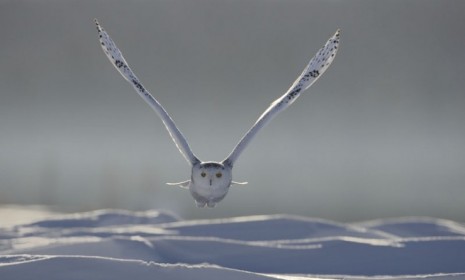America's newest immigration wave: Harry Potter owls?
White snowy owls that look an awful lot like Hedwig are being spotted above the continental U.S., sending birdwatchers and Potter fans into a frenzy

Look up, Potterphiles. You may be able to catch a glimpse of the teenage wizard's favorite pet. Indeed, majestic snowy owls are now flying over the United States in uncharacteristically large numbers. Here, a guide to the owls' unusual migration:
What is a snowy owl?
It's a large white owl that can reach 2 feet in height, with a wingspan of nearly 5 feet — just like Hedwig of Harry Potter fame. Typically, the birds fly south from their Arctic habitat once every four years or so, says Erin Skarda at TIME, generating a few sightings, often in the Bible Belt. But this year's influx is a particularly "massive migration." To date, reports Reuters, about 35 snowy owls have been spotted in Missouri, and 75 in neighboring Kansas.
The Week
Escape your echo chamber. Get the facts behind the news, plus analysis from multiple perspectives.

Sign up for The Week's Free Newsletters
From our morning news briefing to a weekly Good News Newsletter, get the best of The Week delivered directly to your inbox.
From our morning news briefing to a weekly Good News Newsletter, get the best of The Week delivered directly to your inbox.
Why are there more birds than usual?
A plentiful supply of Arctic lemmings, the birds' favorite food, led to a strong breeding season up north, Denver Holt, director of the Owl Research Institute in Charlo, Mont. tells The Associated Press. Now competition for food among the unusual numbers of offspring has sent them flooding into the U.S. to search for everything from voles to rabbits to shore birds.
So this is actually bad news?
In a way, yes. "Many of the birds are suffering," warns Murphy, and some of the owls are just one-third of their normal weight. The birds are also facing "uncommon obstacles" they wouldn't normally encounter in the Arctic, like overhead power lines and fast-moving cars.
A free daily email with the biggest news stories of the day – and the best features from TheWeek.com
When will they go home?
You'll have until at least March to spot the regal birds, when they'll begin the long flight back up to their Arctic home. If you're interested in catching a glimpse, the owls are fairly conspicuous, adds Mike Benbow at Herald Net. "Their large size and coloration make them easy to spot, kind of like a 2-foot-tall snowman." Of course, they do fly 70 miles per hour and are nocturnal, so it's not that easy.
Sources: Associated Press, Herald Net, Reuters, TIME
-
 Ex-FBI agents sue Patel over protest firing
Ex-FBI agents sue Patel over protest firingspeed read The former FBI agents were fired for kneeling during a 2020 racial justice protest for ‘apolitical tactical reasons’
-
 The real tragedy that inspired ‘Hamlet,’ the life of a pingpong prodigy and the third ‘Avatar’ adventure in December movies
The real tragedy that inspired ‘Hamlet,’ the life of a pingpong prodigy and the third ‘Avatar’ adventure in December moviesThe Week Recommends This month’s new releases include ‘Hamnet,’ ‘Marty Supreme’ and ‘Avatar: Fire and Ash’
-
 ‘These moves would usher in a future of chemical leaks’
‘These moves would usher in a future of chemical leaks’Instant Opinion Opinion, comment and editorials of the day
-
 Has Zohran Mamdani shown the Democrats how to win again?
Has Zohran Mamdani shown the Democrats how to win again?Today’s Big Question New York City mayoral election touted as victory for left-wing populists but moderate centrist wins elsewhere present more complex path for Democratic Party
-
 Millions turn out for anti-Trump ‘No Kings’ rallies
Millions turn out for anti-Trump ‘No Kings’ ralliesSpeed Read An estimated 7 million people participated, 2 million more than at the first ‘No Kings’ protest in June
-
 Ghislaine Maxwell: angling for a Trump pardon
Ghislaine Maxwell: angling for a Trump pardonTalking Point Convicted sex trafficker's testimony could shed new light on president's links to Jeffrey Epstein
-
 The last words and final moments of 40 presidents
The last words and final moments of 40 presidentsThe Explainer Some are eloquent quotes worthy of the holders of the highest office in the nation, and others... aren't
-
 The JFK files: the truth at last?
The JFK files: the truth at last?In The Spotlight More than 64,000 previously classified documents relating the 1963 assassination of John F. Kennedy have been released by the Trump administration
-
 'Seriously, not literally': how should the world take Donald Trump?
'Seriously, not literally': how should the world take Donald Trump?Today's big question White House rhetoric and reality look likely to become increasingly blurred
-
 Will Trump's 'madman' strategy pay off?
Will Trump's 'madman' strategy pay off?Today's Big Question Incoming US president likes to seem unpredictable but, this time round, world leaders could be wise to his playbook
-
 Democrats vs. Republicans: who are US billionaires backing?
Democrats vs. Republicans: who are US billionaires backing?The Explainer Younger tech titans join 'boys' club throwing money and support' behind President Trump, while older plutocrats quietly rebuke new administration